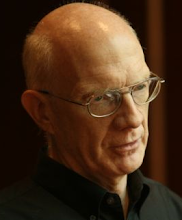
A family friend, Ann Chou, sent me to this link on New York Magazine about "Ghost Riders" or Ghost Bicycles. I must say that I have mixed emotions about this phenomenon. In some ways I feel it is very touching to have remembrances of this kind.
However, I also wonder about what it is exactly that these displays are trying to say. Are they:
- sad, simple, heartfelt memorials?
- some kind of political statement about bicyclists getting insufficient protection?
- warnings about the dangers of practical bicyling?
 n December 6, 2007. It seems to me that this description is inadequate. What really happened, I wonder? I don't know the particular circumstances of Franco's accident, but I do know that I've seen cyclists in urban settings do a number of things that put themselves at risk, often without their realizing it. Things like riding on sidewalks that cross streets and driveways, riding the wrong way on streets, crossing against traffic lights, and generally being unaware of developing traffic situations.
n December 6, 2007. It seems to me that this description is inadequate. What really happened, I wonder? I don't know the particular circumstances of Franco's accident, but I do know that I've seen cyclists in urban settings do a number of things that put themselves at risk, often without their realizing it. Things like riding on sidewalks that cross streets and driveways, riding the wrong way on streets, crossing against traffic lights, and generally being unaware of developing traffic situations.In my thousands of miles of cycle commuting, it is my experience that motorists generally do their best to keep cyclists safe. There are ignorant and impatient motorists, of course, but the truth is this: If a cyclist is going to use the roadway in proximity to automotive traffic, (and mind you, I think that this is a great idea!) then the cyclist, and no one else, is primarily responsible for his own safety.
This may sound a little unforgiving. It may even be unforgiving, but it is by no means impossible or unattainable by an ordinary citizen. All that is needed is education and some practice. I'll pick this theme up again at the bottom of this post.
In the spirit of running the numbers, let's look at the actual causes of seriou
 s injury and death in bicycle and automobile-bicycle accidents. The chart at right comes directly from the sixth edition of the Effective Cycling Instructors Manual, published by John Forester on his website. It presents some pretty non-intuitive numbers, I think, in that motorist error accounts for less than ten percent of serious bicycle accidents. The simple fact that "cyclist error" accounts for one half of the serious accidents suggests that there is some serious educating to be acquired by those who would become practical cyclists.
s injury and death in bicycle and automobile-bicycle accidents. The chart at right comes directly from the sixth edition of the Effective Cycling Instructors Manual, published by John Forester on his website. It presents some pretty non-intuitive numbers, I think, in that motorist error accounts for less than ten percent of serious bicycle accidents. The simple fact that "cyclist error" accounts for one half of the serious accidents suggests that there is some serious educating to be acquired by those who would become practical cyclists.So, let's say you're motivated to begin some practical cycling, say to work or even to a nearby commerical area for some shopping. You've tuned up your bike, you've put together some activewear to ride in, and you've looked at routes on Google maps. What's the next thing to do? Well, it depends on how you might learn best:
- If you want classroom training, take a class sanctioned by the League of American Bicyclists as described on this page of their website;
- If you're a self-paced web kind of person, you can go here to see the League's presentations (which are pretty bare-bones kind of PowerPoint slides, but they do have script content to accompany them.)
- If you want a really complete book, go get a copy of the Bible, Effective Cycling by John Forester. Forester is the Godfather of what is known as "Vehicular Cycling", a protocol governing the safe conduction of bicycles and bicyclists in automotive traffic. It's basically what I've practiced for years.
Thanks, Ann, for the Ghost Cycles link. (I've just added Ann's blog, Sit, Billy., to my blog list. Go visit!)





No comments:
Post a Comment